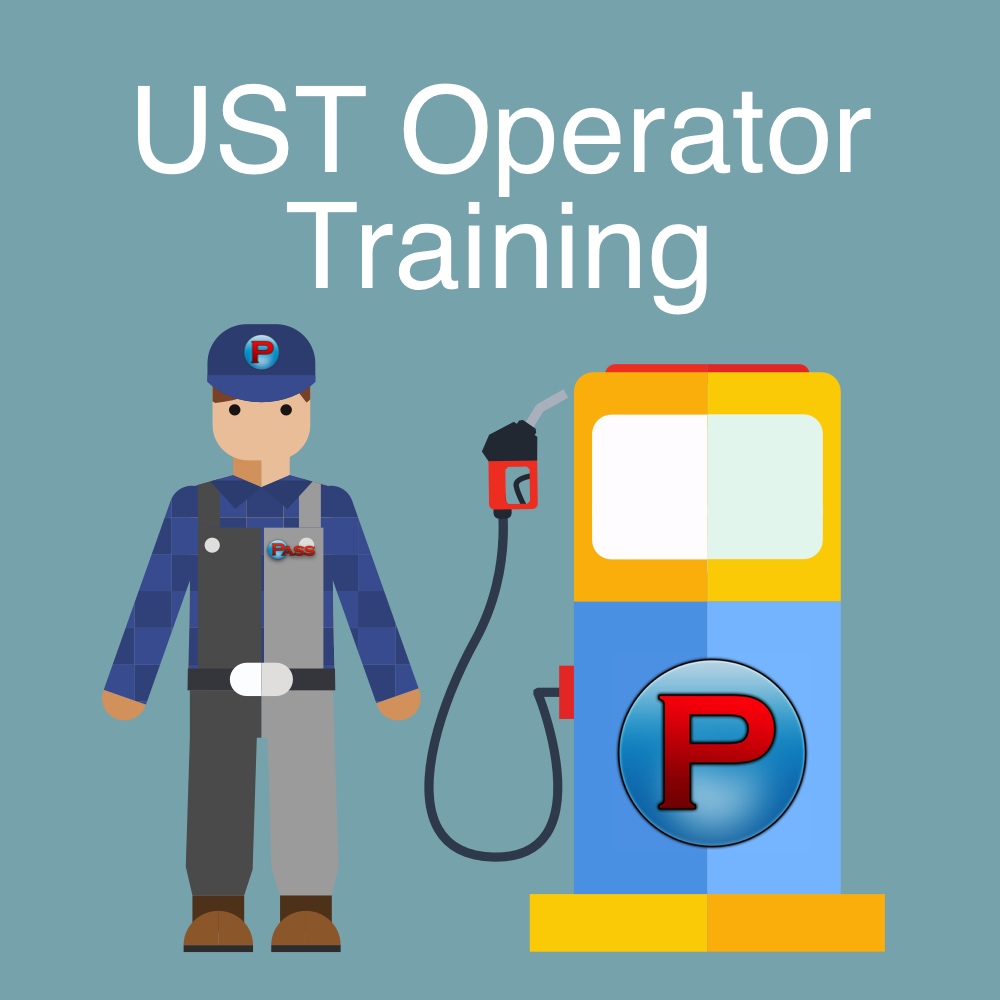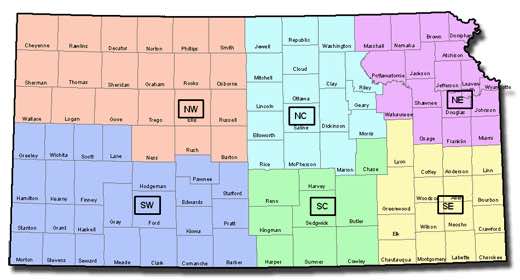Kansas UST Operator Training

UST Operator Certification Procedures
Class A/B Operator Training
In order to earn an A/B operator certification in Kansas, the operator must register for and attend a UST operator training course offered through Tank Management Services. Classes, which usually run from 9:00 am to 4:00 pm, are offered throughout the year in various locations across the state. To see the current course schedule and to register, visit the Tank Management Services website.
Class C Operator Training
PASS' UST C Operator Training is an accepted training method in Kansas.
In order to earn an A/B operator certification in Kansas, the operator must register for and attend a UST operator training course offered through Tank Management Services. Classes, which usually run from 9:00 am to 4:00 pm, are offered throughout the year in various locations across the state. To see the current course schedule and to register, visit the Tank Management Services website.
Class C Operator Training
PASS' UST C Operator Training is an accepted training method in Kansas.
All of PASS’ UST operator training courses meet and exceed the federal requirements for UST operator training and are offered through our in-house designed and built Learning Management System (LMS). PASS’ state-specific training courses are custom-tailored to meet state requirements and are accepted by more states than any other training provider. Our courses are available on-demand, 24/7, and are accessible from any internet-connected computer, tablet, or phone. The student can complete an entire course in a single session or take the course in segments. The training may be stopped and restarted, allowing for maximum schedule flexibility. PASS also does not impose time restrictions on course access, so students may take as much time as they need to complete their training. Once training is completed a certificate is available to save and print.
Registration & Fees
- Registration: Owners/operators of all USTs must register their USTs with the KDHE by submitting a completed Registration Notification for Underground Storage Tanks form. Upon receipt of the form, the KDHE will issue a Storage Tank Operating Permit for each UST.
- Operating Permit and Fees: Owners/operators of existing USTs will receive annual renewal notices around March 15 of every year for existing USTs. After reviewing and/or making changes, owners/operators must send the UST renewal notices to KDHE with fee payments of $10 per tank by April 30 of each year. The KDHE issues UST permits for a period of one calendar year (August 1 to July 31) of the following year. Owner/operators of UST will not receive permits for USTs that do not fully comply with KDHE regulations.
Release Reporting
Owners/operators must report any suspected or confirmed releases to the KDHE immediately. UST releases should be reported to Roger Boeken at (785) 296-1674 or to the appropriate district office for your area. Spills of 25 gallons or more or those that cause a sheen on water should be reported to (785) 296-1679.
Northwest District Office
North Central District Office
2501 Market Place, Suite D
Salina, KS 67401-7699
Phone (785) 827-9639
FAX: (785) 827-1544
NCDOAdmin@kdheks.gov
Salina, KS 67401-7699
Phone (785) 827-9639
FAX: (785) 827-1544
NCDOAdmin@kdheks.gov
Northeast District Office
800 West 24th Street
Lawrence, KS 66046-4417
Phone: (785) 842-4600
FAX: (785) 842-3537
NEDOAdmin@kdheks.gov
Lawrence, KS 66046-4417
Phone: (785) 842-4600
FAX: (785) 842-3537
NEDOAdmin@kdheks.gov
Southeast District Office
South Central District Office
300 West Douglas, Suite 700
Wichita, KS 67202-2921
Phone: (316) 337-6020
FAX: (316) 337-6055
SCDOAdmin@kdheks.gov
Wichita, KS 67202-2921
Phone: (316) 337-6020
FAX: (316) 337-6055
SCDOAdmin@kdheks.gov
Southwest District Office
302 West McArtor Road
Dodge City, KS 67801-6014
Phone: (620) 225-0596
FAX: (620) 225-3731
SWDOAdmin@kdheks.gov
Dodge City, KS 67801-6014
Phone: (620) 225-0596
FAX: (620) 225-3731
SWDOAdmin@kdheks.gov
Release Detection
UST owners/operators in Kansas may use any of the following methods of release detection:
- Manual tank gauging;
- Automatic tank gauging (ATG);
- Groundwater monitoring;
- Vapor monitoring;
- Interstitial monitoring;
- Statistical Inventory Reconciliation (SIR); or
- Tank tightness testing.
Regardless of which method is used, owners/operators must also conduct inventory control at each facility. Release detection methods must be third-party certified by the National Work Group on Leak Detection Evaluations (NWGLDE).
Release Prevention
Spill protection is designed to eliminate releases caused by spillage from the transport hose while filling a tank. State and federal regulations have requires that all active regulated USTs have spill buckets installed around fuel risers since December 23, 1998. Spill buckets should hold a minimum of 5 gallons of fuel, but 10 to 25 gallon buckets are commonplace. To be effective, spill buckets should be kept clean and free of debris. Spill buckets full of water or fuel should be emptied as soon as practical.
Overfill protection must either automatically shut off the flow of product into a tank when the tank is 95% full or alert the operator when the tank is 90% full. All tanks that receive more than 25 gallons of product at one time through deliveries or additions have been required to have overfill prevention since December 23, 1998.
Financial Responsibility
Kansas follows the federal financial responsibility coverage amounts found in 40 CFR §280.93 (scroll to page 77 of 119 in the pdf document). Owners/operators may use any of the following mechanisms to demonstrate financial responsibility.
- Financial test of self-insurance
- Guarantee
- Insurance and risk retention group coverage
- Surety bond
- Letter of credit
- Trust fund
- Stand-by trust fund
Owners/operators may also use the Kansas Petroleum Storage Tank Release Trust Funds for assistance with remediation costs.
Inspection & Testing Requirements
Kansas UST regulations require that all USTs be inspected every three years by a Kansas Department of Health and Environment (KDHE) inspector.
Delivery Prohibition/Non-Compliance Enforcement
The KDHE will annually issue Storage Tank Operating Permits for USTs that are in compliance with UST regulations. If a UST does not have a current operating permit, fuel deliverers will receive certified letters instructing them not to deliver fuel to non-compliant facility or face fines. The KDHE website also lists the permit status of each UST in the state.
Temporary & Permanent Closure
Temporary Closure
Underground storage tank release detection requirements can be deferred for up to 12 months for currently active tanks, if the tanks are temporarily abandoned. The steps to temporarily abandon your regulated underground storage tanks are listed below:
- The tanks must be emptied.
- The fill pipe and gauge opening must be sealed;
- The product lines must be sealed; the pumps locked, and the electrical power shut off;
- The vent lines must remain open.
- If your underground storage tank system includes impressed current cathodic protection, do not shut-off electrical power to the rectifier. KDHE will continue to require cathodic protection tests if your USTs are protected by impressed current or sacrificial anode cathodic protection systems.
- Inform your 3rd Party Liability Insurance carrier that you will no longer be storing regulated substances in your underground storage tank system while its status is changed to “Temporary-out-of-Service.” However, do not drop the 3rd Party Liability Insurance for these tanks. KDHE requires that owner/operators of USTs continue to demonstrate financial responsibility for USTs that remain in the ground.
- Please continue to pay yearly tank registration fees for your underground storage tank system while it is “Temporary-out-of-Service.”
Please inform KDHE in writing that you wish to temporarily abandon your USTs:
Kansas Department of Health and Environment Bureau of Environmental Remediation
Storage Tank Section
1000 SW Jackson, Suite 410
Storage Tank Section
1000 SW Jackson, Suite 410
Topeka, KS 66612-1367
“Temporary-out-of-Service” underground storage tank systems may be brought back into service by upgrading to meet KDHE requirements for tank and line release detection, inventory control, spill prevention, overfill prevention, and corrosion protection. If you have any questions, please call 785-296-8061.
Permanent Closure
KDHE recognizes two methods to permanently close underground storage tank systems: removal or in-place abandonment. Kansas-licensed UST removers must complete the work to permanently close UST systems and notify KDHE of the permanent closure with a “Permanent Tank Abandonment (UST008)” form.
An environmental site assessment is required for any UST to be permanently closed. KDHE must be notified before an UST can be removed or abandoned in place. With adequate notice, the KDHE field staff can inspect a tank removal site and perform a site assessment at no cost to the owner. If a tank is to be abandoned in place, the owner must hire an environmental professional to perform a Phase II site assessment prior to abandonment. Once KDHE has evaluated the site assessment and approved the closure, Kansas-licensed UST removers may fill the tank with an inert solid material such as sand. If contamination, exceeding KDHE standards, is discovered at any closure site, remedial action will be required.
More information on the permanent closure of UST systems can be found in the “Corrective Action Policy Manual.” This document is available from KDHE and can be downloaded from the Storage Tank Section Download Page at:
http://www.kdheks.gov/tanks/download/Corrective_Action_Policy_Manual.pdf
http://www.kdheks.gov/tanks/download/Corrective_Action_Policy_Manual.pdf
5 Products

Kansas UST Class C Operator Training
UST Operator Training UST Class C Operator Training Kansas
/ 191 Reviews

Marina Add-On Training - Class A/B
Add-On UST Operator Training UST Class A/B Operator Training National
/ 19 Reviews

Marina Add-On Training - Class C
Add-On UST Operator Training UST Class C Operator Training National
/ 29 Reviews

Non-Retail Facility Add-On Training - Class A/B
Add-On UST Operator Training UST Class A/B Operator Training National
/ 19 Reviews

Non-Retail Facility Add-On Training - Class C
Add-On UST Operator Training UST Class C Operator Training National
/ 22 Reviews
